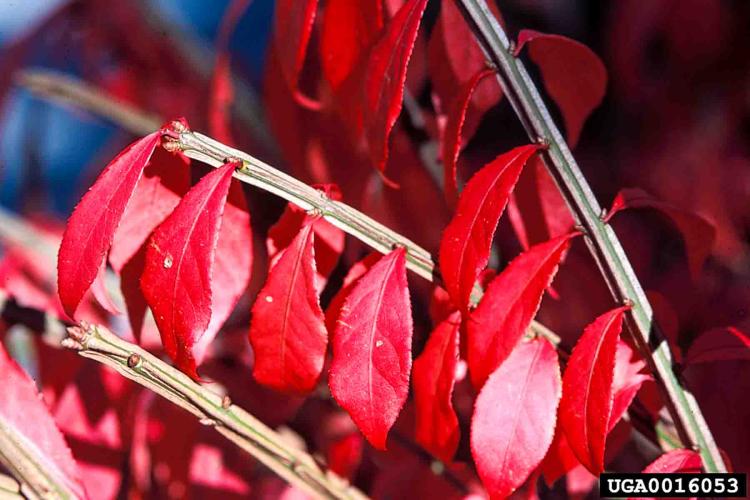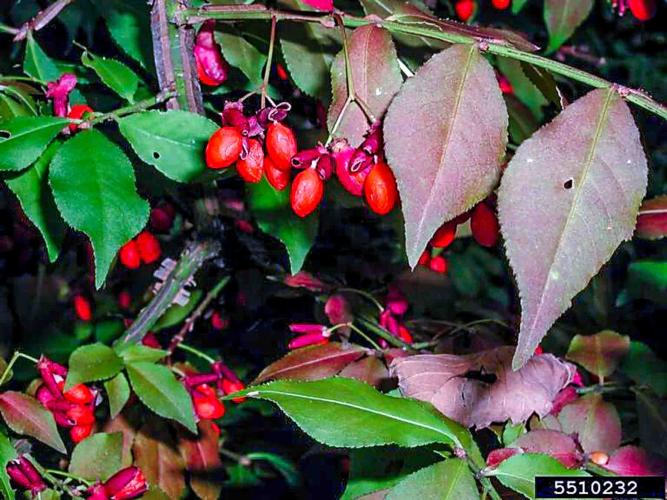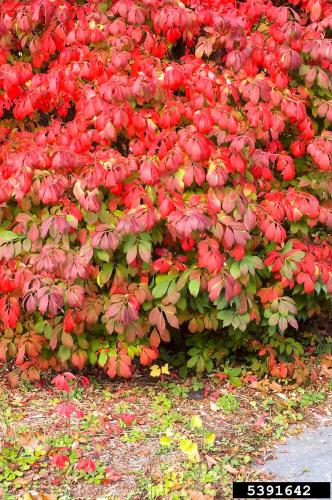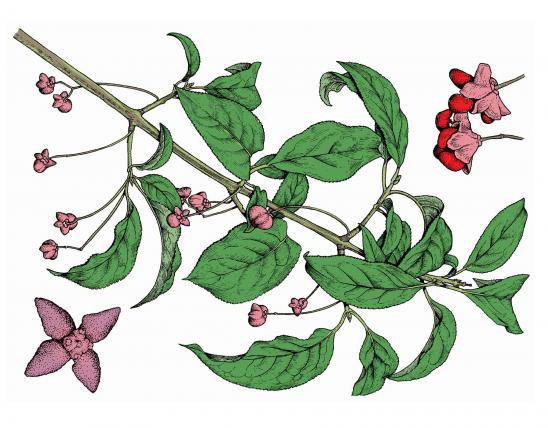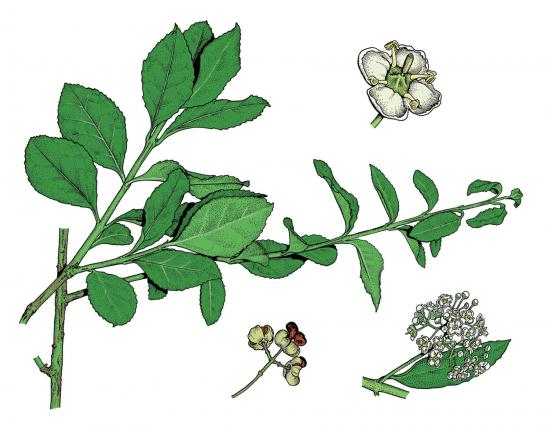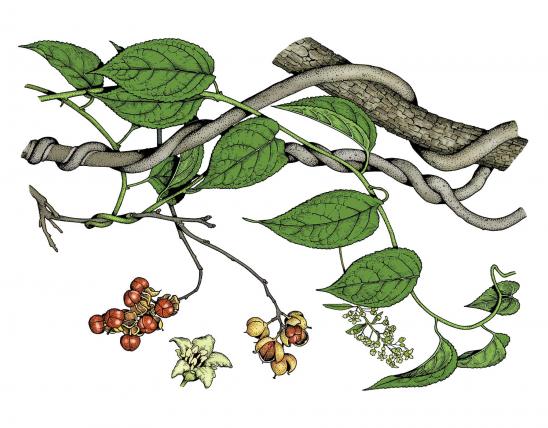
Burning bush, or winged euonymus, is a nonnative shrub that can grow to 15–20 feet high and has corky wings on the twigs. It has been very popular in landscaping because of its bright red fall foliage. It is invasive, however, and spreads aggressively into natural habitats, displacing native species.
Leaves are opposite, simple, 1–3 inches long, ½–1¼ inches wide; tip pointed; base wedge-shaped; margin finely and sharply toothed; upper surface medium to dark green, smooth; lower surface paler, smooth to somewhat hairy; leaf stalk short.
Bark is gray and tight; pores raised, narrow, and light tan.
Twigs are smooth, green to brown, with 2–4 ridges of corky wings; wings are ¼–½ inch wide. Generally, the more vigorous shoots have the largest wings.
Flowers May–June, in clusters of 3–8, from the axils of leaves or nodes; stalks slender, 1–2 inches long; flowers yellowish green, about ½ inch across; petals 4, spreading, oval to broadest above the middle, margin wavy; stamens 4, alternating with the petals and arising from the edge of the disk.
Fruits September–October; capsule deeply 4-lobed, about ¼ inch long, red, splitting open to expose and orange to red seed coating; the seeds often dropping with the leaves in autumn.
Similar species: Missouri has several members of the staff tree family that you might encounter in nature. Here are some common relatives that also have a shrubby growth habit:
- Eastern wahoo (E. atropurpureus) is a native shrub or small tree that grows in wooded areas, near streams, and in thickets. In fall, dainty pink or purplish four-lobed fruit capsules dangle from its branches. Its twigs are somewhat 4-angled, but they do not have the corky wings characteristic of burning bush. Wahoo deserves to be used more in landscaping.
- Strawberry bush (E. americanus) is rare in our state, occurring in southeast Missouri and north to the St. Louis area, in low, sandy woods along spring branches, low moist woods, moist wooded slopes of Crowley’s Ridge, and moist stream banks. This Missouri native has attractive dark green leaves that remain on the branches long into autumn, and it bears unusual pink, warty fruits that open to display colorful orange-red seeds. Much of its Missouri habitat has been destroyed, and like wahoo, it is a good choice as a native landscaping shrub.
- Running strawberry bush (E. obovatus) is a very small shrub (less than 18 inches tall) that creeps along the ground and forms dense mats. The trailing stems can be up to 3 feet long. The foliage holds its green color well into December. The flowers have 5 petals and 5 stamens. Fruits have a pink, warty outer surface; exposed seeds are bright scarlet red. Occurs mostly on north-facing, moist, wooded dolomite slopes or at the base of dolomite bluffs, mostly in the southeastern quarter of the state. May be confused with invasive wintercreeper.
- Wintercreeper (E. fortunei) is a nonnative, invasive, evergreen woody vine that forms a dense, trailing groundcover. It can become shrubby and can climb 20 feet or higher with aerial rootlets that cling to tree trunks and other structures.
Height: to 15–20 feet. In cultivation, these shrubs are typically kept trimmed to smaller sizes.
Cultivated statewide; escapes statewide. The native range of this invasive shrub extends from northeastern Asia to central China (Russia, Japan, China, and Korea).
Habitat and Conservation
Introduced to our continent from Asia; a popular landscaping shrub. Landowners typically trim it in a spherical shape, or grow it as a hedge. Escaped and naturalized populations are most commonly found in open woods and thickets near towns and cities or at old homesites. Unfortunately, this species has been increasingly appearing in native habitats, indicating its aggressive, invasive tendencies.
Burning bush invades natural habitats when birds and wildlife eat the orange, fleshy fruits and later, elsewhere, drop the undigested seeds in their excrement. Once established in a favorable area, this species can form large thickets, displacing native plants.
The Missouri Invasive Plant Task Force has conducted research that indicates that burning bush is projected to cause severe environmental degradation in the northern half of Missouri, with moderate degradation in the southern half. Current escaped populations are considered moderate in the southern half of Missouri, with a trend for moderate increase along the Missouri River and Osage Plains.
Status
Nonnative, invasive shrub commonly used in landscaping.
Birds are attracted to the berries of burning bush and easily distribute the seeds. The seeds germinate, and colonies of burning bush become established in woodlands, forests, fields, and roadsides, forming dense thickets and outcompeting native plants.
Human Connections
With its striking pinkish-red foliage in autumn, it’s easy to see why burning bush has been popular as a landscaping shrub. Many Missourians have planted it as a hedge along borders, in foundation plantings, and for screening.
Unfortunately, this plant has proven invasive. An invasive species is an aggressive, nonnative species whose presence causes or is likely to cause economic or environmental harm. It not only can survive on its own in the wild, it also reproduces and spreads into nature habitats, displacing native species.
Burning bush can be controlled with herbicides, by pulling small seedlings, and by repeatedly cutting shrubs to the ground to control resprouts. It's best not to plant burning bush in our state.
Instead of planting invasive burning bush, choose native shrubs that have great value for birds and other wildlife. Suggestions include
- eastern wahoo (Euonymus atropurpureus), which has attractive red berries and red fall color;
- strawberry bush (Euonymus americanus), quite similar to burning bush but native and a Missouri species of conservation concern;
- black chokeberry (Aronia melanocarpa), which has glossy, deep green leaves that turn wine red in fall, and white flower clusters that turn into black fruits;
- fragrant sumac (Rhus aromatica), a low, colony-forming shrub that can turn a rainbow of colors in fall and bears clusters of fuzzy red fruits you can make tea from; and
- smooth sumac (Rhus glabra), a taller colony-forming shrub with feather-compound leaves that turn brilliant reddish purple in fall.
The genus name, Euonymus (pronounced yew-ON-uh-muss), is from Greek roots meaning “true name.” The species name, alatus (ah-LAY-tuss), means “winged,” referring to the corky wings along the twigs.
Ecosystem Connections
The fruits of burning bush are eaten by a number of birds, including wild turkeys. Birds and other wildlife eat the fruits, later distributing the seeds into natural habitats.
Deer apparently find the foliage unpalatable, so in places where deer are plentiful, burning bush tends to increase as the deer eat other, tastier plants first.
Several types of small bees and flies visit the flowers. A variety of insects feed on various parts of the plant. Scales suck the juices, beetles bore into the stems or chew the roots, and moth caterpillars and beetles eat the leaves. The black bean aphid (Aphis fabae), a widespread pest of several agricultural crops, may use burning bush as an overwintering host.
Burning bush is one of several nonnative species that invade natural habitats, forming dense thickets, displacing native species and disrupting ecosystems. At least 20 U.S. states have declared it invasive, noxious, or both. At least three New England states have prohibited the sale and importation of this species.




